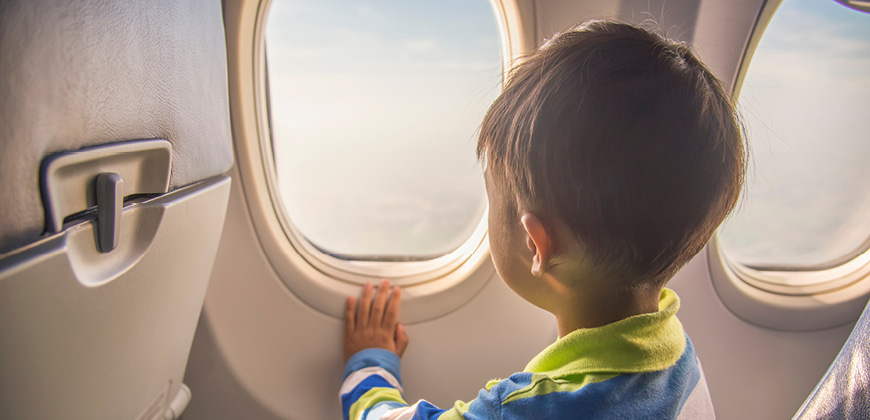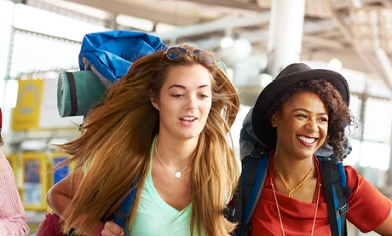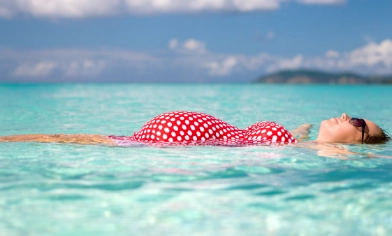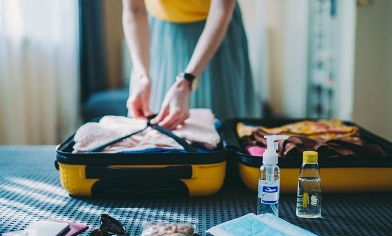Pre-flight preparation
You’ve booked your flights and you know what to expect while you’re in the air. Now comes the planning for either end.
Always bear in mind that flying can be a magical and exciting experience for kids, especially the first few times. So throughout, it can pay off to make it seem as fun as possible.
-
Dress them in something memorable
You might be sitting in a terminal for a while. Dressing them in something easy-to-spot will be important if they should wander off.
-
Take a photo of them on your phone
Once they’re in their memorable outfit, take a photo with your phone. If they go for an unexpected explore, it’s much easier for others to help find them if they know what they’re looking for.
-
Bring their furry friends
No, not pets. But stuffed toys that they love can be comforting and familiar in a busy environment. And they can double-up as pillows during the flight.
-
Make sure your gadgets are match fit
Gadgets can be your best friends when keeping kids entertained. Tablets and phones have any number of games and streaming services available. So whatever you need – from an iPad to Bluetooth headphones – make sure they’re fully-charged and fully-functional, and bring a portable battery pack to give something more juice should they run low.
Remember that, particularly in the UK, power points in airports can be hard to find. Don’t rely on any being available.
-
Plan for delays
Hopefully everything will run smoothly. But if they don’t, it could be stressful if you haven’t anticipated being stuck at the airport for a while.
Some travel insurance policies include (known as flight delay assistance, which can help make prolonged stays in departure lounges more comfortable.
-
Give yourselves time
You might have yourself totally under control and be used to waltzing through security straight onto your flight. But kids have minds of their own and are talented at complicating things. Make sure you’ve got plenty of time for snacks, trips to the loo and perhaps the odd tantrum.
-
Keep it light
Maintaining the idea of excitement, fun and the magic of travel can make the environment an adventure rather than a threat.
Make sure your hand luggage has everything you need
Anything that’s in your hold luggage will be out of action from the point you check it in to the time you haul it off the baggage reclaim belt the other end.
So make sure that everything you could possibly need is in your hand luggage. Here’s a quick checklist to help you out:
- Wet wipes and hand sanitiser
- Snacks and treats
- Boiled sweets (such as lollipops) – we’ll come to those in a minute
- Tablets, handheld gaming devices, battery packs
- Pens and paper
You know what your children like to do best, so be sure to pack it. And remember that they might be able to take hand luggage of their own if they’re over a certain age. Just make sure they don’t lose it.
Flying with a baby
Flying introduces a whole new world of discomfort to babies, so you can help your baby and yourself by planning for them.
Plan ahead
The first thing to do is make sure your baby is old enough to fly when booking your flights. In general, you’re unlikely to be booking a flight for immediately after giving birth, so it’s probably not an issue, but airlines have differing policies on what a minimum age to fly is.
It is normally two weeks old, but there is some variance so make sure you check this before booking.
Do I need a baby passport?
Yes. Everyone travelling needs a passport, even very young babies. Getting one, however, can take time. So make sure you book flights to factor in the maximum amount of time this could take.
To (known as apply for an infant passport you need to apply with a completed application form, your baby’s birth certificate and two identical colour photos of your baby with a signature from a professional who has known you for at least two years.
There are strict rules for adult passport pictures (light background, no one else in the picture, both eyes open, etc.) but the passport office are a little more relaxed when it comes to babies.
Check the government’s advice on (known as passport requirements and the application process. And you can use the (known as Post Office Check & Send service to make your application.
Baby essentials checklist
Firstly, planning is everything. You know how often your baby needs feeding so you can plan for this. Always take more than you need in case of delay.
No one aims to leave something behind. But in the stress of getting ready, anybody can be forgiven for not keeping track of absolutely everything. Here’s a checklist to help you tick things off:
- Nappies
- Changing mat
- Teething ring
- Milk / powdered milk
- Food and snacks
- Wet wipes
- Dummies
- Toys
- Blanket
- Cotton wool
- Books
- Pram/stroller/bassinet
- Car seat
- Water sterilisers
- Bottles
- Muslins
- Travel cot
- Clothes (for you both)
- Rusks (if you need them)
- Nappy bags
- Calpol
- Anti-histamines
- Nappy cream
- Moisturising cream
- Sheet for travel cot
- Bibs
- Baby cutlery
- Beaker
- Nasal aspirator
- Sun cream
- Sun hat
Make sure you've got the items you need with you in the cabin for the flight, as long as they are allowed. Check with your airline which of the items listed can be transported in the cabin and which need to go in the hold.
Travelling with a toddler
Toddlers have different needs to babies and require a different approach when planning travel.
The name of the game is staving off boredom. Boredom is the lit fuse under tantrums, sulks and all manner of undesirable eventualities. So having a varied source of amusement is crucial.
Once again, preparation is key. We’ve already taken a brief look at what kind of preparation you can do to keep your little ones entertained in the departure lounge and during a flight. Here we go into a little more detail.
-
Games
The most obvious thing to give your toddler(s) is the ability to occupy themselves with games and activities. Tablets and smartphones are a great resource as they can contain a huge variety of games in one place.
But, like the rest of us, kids can get fatigued by looking at a screen for too long. It’s also important to have a ready supply of books, colouring books and old-fashioned games (such as cards) for more interactive entertainment.
-
Staying safe
As well as having a photo of your child on your phone in the clothes they’re wearing, you can also consider having them wear a bracelet with your phone number on it.
Spillages and accidents can happen at any time. Make sure you’ve got the necessaries to deal with whatever might occur, from spare nappies to spare clothes – and a plentiful supply of wet wipes.
Bring plenty of healthy snacks. Not only is this important for when they get peckish, but can also be a last-ditch way of averting the boredom.
Also, pack hard sweets like lollipops. The change in air pressure as you take off and level out at altitude can be incredibly painful – everyone who’s flown will know the sensations – but it’s especially acute for those unused to it. Sucking sweets can help ears pop and return to the correct pressure.
On the plane
What can I take on the flight?
There are strict regulations about liquids on flights. Fortunately, baby milk, baby food and formula aren’t included in this, though you might be asked to taste the food for security reasons. Everything else is, so if you have more than 100ml of something you need – such as nappy cream – you’ll probably be asked to throw it away.
Your pram/stroller/bassinet will go in the hold. Depending on the airline, your baby may be allowed to sit on your lap during the flight . Some airlines require babies to be secured in a car seat on a seat of their own. So if you’re taking a car seat with you, whether it goes in the hold or the cabin will likely depend on the airline’s own policy.
Food and snacks are usually fine to take through security. To make things nice and easy, don't bring anything that's particularly messy or sticky.
Read our full guide to (known as what you can take on the plane.
Have a good flight!
The cabin crew are trained to help you with your baby should you need it during the flight. Don’t be afraid to ask what to do if you’re unsure.
Keep an eye out for spare seats. If your flight is under-booked then there maybe spares where you and your child can stretch out for a nap if your own seats are too cramped. But make sure to stay with your child if they want to move.
Sucky sweets, as mentioned before, can help ears pop, so be sure to bring some.
Other travel problems
Nervous flyers
Lots of people are nervous flyers. If your child appears that they may be anxious at the prospect, helping them to frame the experience as fun, safe and adventurous may help.
Knowledge is power, as the saying goes, so you can take them through how planes work and mention that (statistically) it is the safest mode of transport on earth.
Motion sickness
Motion sickness is caused when your eyes and your inner ear can’t agree on what’s going on, and it can be very unpleasant. It is especially common in children and while it’s typically at its worst on ships, in cars and on fairground rides, it can occur on planes too.
There are a range of treatments available but not all of them work on every person. So if you know that your child suffers from motion sickness, make sure you’re stocked up with the treatment that works best for them.
Stay fed and watered
Flying can cause dehydration, particularly in children. Even if they don’t feel like it, make sure your kids are taking enough fluids. You know what they like best, so you might want to bring enough of it to get through a long stint in an airport. Remember that you can’t take it through security though.
Hunger can also make for irritation and bad mood. Keeping a ready stash of snacks on-hand can mean you’re prepared to handle the hunger demons.
Keeping kids safe
Airports can be large, noisy and busy places where it’s important to be able to keep an eye on your kids. Similarly, once you’re on holiday, your tried-and-tested routine at home for keeping everyone safe and accounted for might need a few tweaks. Here are some thoughts on keeping kids safe when travelling.
-
Make a plan that lasts the whole holiday
Before you go away, you can give your kids a plan to follow should they become lost that they can follow in most circumstances. For instance, create a list of trusted people they can ask for help – such as police officers, a member of hotel staff or other parents with small children.
-
Prepare for the unexpected
When you’re travelling, keep a wristband on your child with your mobile number on it. No one wants to think about their child getting lost, but if they do, this is a good way for anyone finding them to get in touch with you.
-
Know your surroundings
You can make sure you’re familiar with an area before you leave with the help of increasingly sophisticated online maps. This is a good way to be aware of any hazards (like areas with strong tides, for example) as well as planning places to meet.
Online research can also help you identify where all the swimming pools are from a safety standpoint, or where to access the nearest medical facilities or pharmacies if needed. If you can’t find this out before you go, make sure your find out when you check in at your accommodation. You could ask at the same time as finding out when your reps are available.
The same applies to your room. You know your child best, as well as which hazards might worry you. So if you see balconies with railings which are too far apart, or some dubious electrics, tell your venue’s management.
-
Sun protection galore!
Children’s skin is more vulnerable to sunburn that adults’ and so you will need a higher factor sun cream than you take for yourself. Make sure you are reapplying this sun protection periodically throughout the day, even late in the day when the sun can still be strong, and especially if they like playing in the sea or pool. Sunburn and prickly heat can be distressing for children – more so than for adults – and it’s an easily avoidable situation with the right planning.
Don’t forget a sunhat as well as a T-shirt that your kid doesn’t mind soaking and potentially sun-bleaching in case they get burned and still want to play in the sun. Make sure your child drinks plenty of water throughout the day – and that goes for you, too. The same applies to ski trips, where the glare from the snow can intensify the sun’s burning potential.
-
Know the risks of the sea
Swimming in the sea is great fun, especially if you get to do it somewhere that doesn’t feel like you’re jumping into an ice bath.
Only swim in parts of the sea where it’s safe to do so and there’s a lifeguard in attendance. You might want to (known as research rip tides and currents and practise identifying them, as well as what to do if you find one.
-
Ghic and travel insurance
If you’re travelling in the EU, make sure you have a (known as UK Global Health Insurance Card (Ghic) or a valid (known as European Health Insurance Card (Ehic), which the Ghic has replaced. These cards are free and entitle you to emergency and necessary state healthcare in EU countries for the same costs as residents. If you need such treatment, you’ll get it at substantially less than without a card – possibly even free in some countries.
It’s also vital to have good (known as travel insurance when you go away. It may protect you while you're away in the event of emergency requirements a Ghic or Ehic wouldn’t cover, such as air rescue or repatriation to the UK if needed. It may also help safeguard against a whole host of holiday issues too, including loss, theft and damage of personal possessions, cancellations and delays.
-
Pack enough medicine
Bring enough of the medicines that your children need to last you the whole holiday (as well as anything they might need in-flight).
If you need to take a prescription medicine, make sure you bring copies of the prescription as well a doctor’s notes explaining why it’s needed. Remember that it could be on a list of prohibited medicines in the country you’re visiting, so contact the relevant embassy if you’re in doubt.
Check our 10 tips for (known as keeping your kids safe on holiday.













